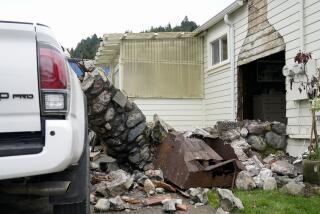FORECASTING : Weather Service Retools, Sets Its Sights on Greater Accuracy
- Share via
WASHINGTON — Television weatherman Bob Ryan has heard all the jokes. He’s heard all the whining about off-the-mark predictions and unreliability.
“If we get 90 out of 100, we missed 10. If we get 99 out of 100, we missed one,” says Ryan, a meteorologist at local NBC affiliate WRC-TV.
But weather forecasters and the National Weather Service, which provides them with information to develop forecasts, may not be the butt of jokes for much longer.
The NWS is updating its measurement equipment with a cutting-edge radar, supercomputer and satellite as part of a $4.2-billion modernization--a move the agency, which has come under fire for failing to give early warnings of tornadoes and hurricanes in addition to botching everyday predictions, acknowledges is long overdue.
Using the high-tech system, parts of which are already operating in Los Angeles and many other major cities, forecasters will be able to see everything from clear skies to summer squalls more quickly and more clearly, weather officials say. NWS forecasts are the basis for newspaper weather maps and television weather reports.
In the United States, weather can be a dangerous business. In a typical year, the mainland sees 10,000 violent thunderstorms, some 1,000 tornadoes and several hurricanes. And the United States experiences more severe flooding than any other nation, according to the National Oceanic and Atmospheric Administration, which oversees the NWS.
In meteorology, accuracy is everything, weather-watchers say. And every little bit helps.
With the new NEXRAD Doppler radar, forecasters will be able to peer inside storms for the first time and examine wind rotation, which can indicate when maelstroms or tornadoes are in their early stages. NWS storm experts expect that the system will give them about 30 minutes extra notice of approaching tornadoes.
In cold climates, the Doppler system allows forecasters to measure snowfall intensity, something conventional radar cannot do, and issue warnings “with more confidence,” said Bob Thompson, an NWS meteorologist in Taunton, Mass.
The weather service also bought an advanced supercomputer, the $45-million Cray Research Inc. C90 mainframe, which can process 15 billion math operations per second. The computer will use mathematical formulas to copy the movement of the atmosphere. Using those formulas as models, forecasters try to determine what weather systems will do next.
The computer also provides information for more precise areas, analyzing conditions in zones of just 25 square miles--or one-fourth the size of the former system.
Jack Williams, who has compiled data for USA Today’s weather page since the newspaper started publishing 12 years ago, said he is “looking forward to the Cray, which can run more localized computer models.”
With the power to process six times as much data as the old system in one-fifth the time, the mainframe will “help Americans in all walks of life make better daily decisions where weather is concerned,” said Elbert W. Friday Jr., assistant administrator for weather services for the NOAA.
The supercomputer will oversee data processing from radar, satellites and a new automated measurement system.
In May, the NWS launched its own weather satellite, GOES-1, giving U.S. forecasters more than one working satellite in space for the first time since 1986. For the last eight years, NWS meteorologists have had to borrow the services of a European satellite.
The NWS is also installing automated weather-measuring stations across the country. Each station will collect data ranging from wind speeds to barometric pressure and send it to one of the service’s weather forecasting offices situated in each state. Weather officials say the new system will be more accurate than human data collectors, although the NWS union is protesting because several field offices are being relocated.
More to Read
Sign up for Essential California
The most important California stories and recommendations in your inbox every morning.
You may occasionally receive promotional content from the Los Angeles Times.










